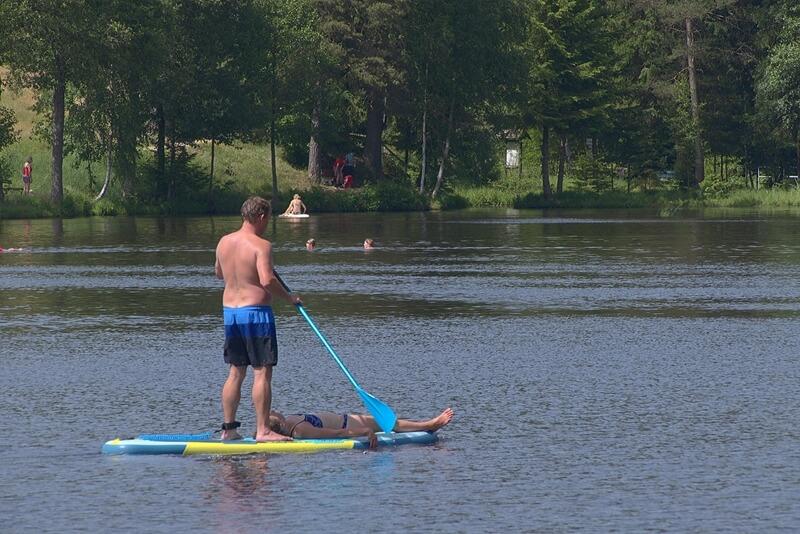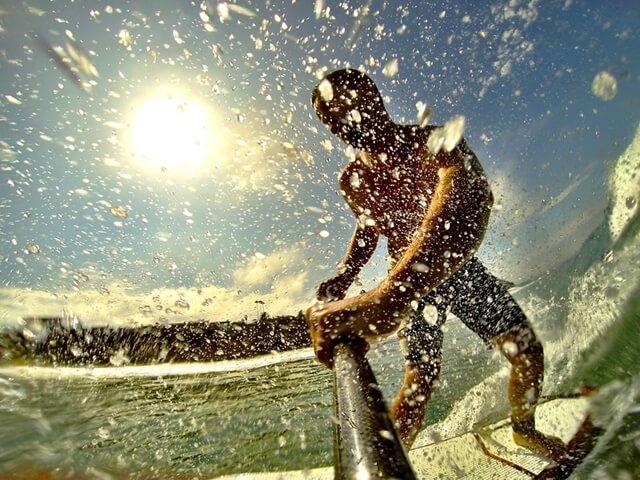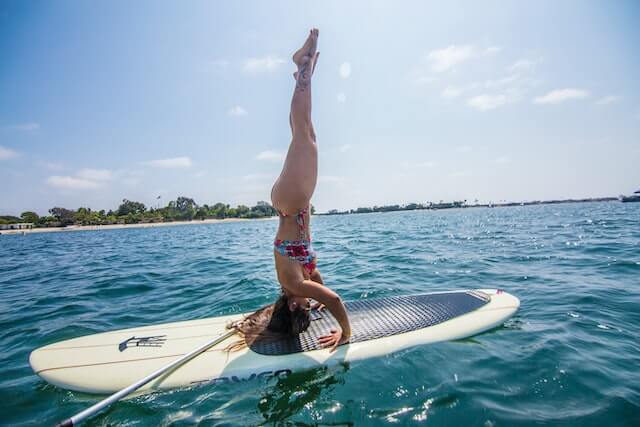Stand-up paddle boards (SUP) provide a fun option for you to experience a range of different water environments, from calm lakes to surf beaches, to paddling down rivers and experiencing white water rapids, and anywhere else you want to go on the water.

You get a well-balanced board that feels as though you’re gliding along the water, and from a standing position, you get a unique viewpoint of seeing further as well as easily seeing what’s beneath you.
Picking the right stand-up paddle board for your skill level and the activities that you want to perform will be crucial to getting the most enjoyment or getting the best results from your SUP experience.
Pick A Stand-Up Paddle Board Based On Activity
The first thing to ask yourself when picking a SUP is what are you going to be doing with it, as different activities and environments have different requirements from your SUP. While any SUP can be used in any environment, you’ll have an easier time if you pick the right features.
Most brands and stores will group stand-up paddleboards into a few specific categories for you to pick from more easily.
All-Around Stand-Up Paddle Board

All-Around SUPs are a great entry-level board for beginners to learn to paddle on calm water, such as lakes, inlets, or bays. The goal of this type of board is to be very stable, so they’re long and wide in relation to your body type, have high volume, and the nose will typically be rounded.
These boards can provide an excellent workout, allow you to bring extra gear on the board with you, and let you explore an area leisurely and with a lot of stability. They’re not going to be exceptionally fast or as maneuverable as other SUPs.
Surf Stand-Up Paddle Board
For intermediate or advanced paddlers, you may be looking for a surf SUP to get out into the waves that are typically for surfers or bodyboarders. These SUPs are shorter and tapered, which provides better maneuverability that is required when surfing waves on a SUP.

Surf SUPs will typically have an upturned nose and tail, which makes them easier to turn and move in waves.
They can be used in other environments, but you’ll find them much slower when going in straight lines across flat water, so only get a surf SUP if you plan to hit the surf with it.
Yoga Stand-Up Paddle Board
Performing yoga on a SUP has become much more popular in recent years, and there are boards specifically designed for it. You get the advantage of a slightly unbalanced surface, and you can perform your yoga out in nature in different environments away from people.


You can use an All-Around SUP to perform your yoga, but if you get a specifically designed yoga SUP, you’ll find that it’s as long or longer than an All-Around and will be wider with blunt ends as the goal isn’t to travel but stay balanced.
You’ll often find that yoga SUPs also have a pad running the length of it to provide extra grip when performing yoga poses, which also gives some added comfort.
Touring and Racing Stand-Up Paddle Board
Touring or racing SUPs provide the ability to go long distances at speed on open water; they’re designed to be longer and narrower than an All-Around SUP, so they’re faster and more maneuverable, but they’re less balanced, which can be challenging for a beginner.

Typically they have a displacement hull and a more pointed nose to help push through choppy water, and they’re thicker than other boards so you can carry more weight, such as your travel supplies.
Racing SUPs are essentially touring boards at set lengths for competitions, 12’6, 14’0, and unlimited length.
Whitewater Stand-Up Paddle Board
Whitewater SUPs come in two varieties depending on how you like to ride your whitewater:
- River runnings are longer and not as wide to give maximum speed.
- River surfers are shorter and often have upturned noses and tails to have more maneuverability in the whitewater.
You’re also going to see different materials, such as polyurethane SUPs or even inflatable SUPs, as they need to handle hitting rocks and other debris under the water.
Key Factors In Picking A Stand-Up Paddle Board
If a brand or store isn’t grouping or naming their SUPs into standard categories, you can still pick out the best SUP for your activity based on a few key factors, including hull shape, length, width, thickness, and some of the features such as the fins attached.
Stand-Up Paddle Board Hull Shape
SUPs come in two main hull shapes, either a planing hull or a displacement hull. It’s one of the primary differentiators when picking your SUP based on activity.
Planing hulls are flat and wide; you get better maneuverability and stability. Most beginners will do well on a planing hull, and it allows for a variety of different activities. All-Around SUPs will have a planing hull, as will yoga, whitewater, and surf SUPs.
Displacement hulls are typically narrower and have a pointed nose which helps cut through choppy water and allows you to go faster and further than a planing hull. Most racing or touring SUPs will have this type of hull shape, and leisure paddlers can also pick a displacement hull if their goal is to explore further away.
Solid vs. Inflatable Stand-Up Paddle Board
Solid SUPs can be made from a variety of materials which impacts the weight and comfort of your SUP, but typically a solid SUP will have better performance overall than an inflatable SUP.

The range of solid SUPs is more extensive; they come in many more lengths, widths, and thicknesses, so you can get a better fit for your specific requirements.
Inflatable SUPs can be a better option depending on your requirements, such as durability and impact resistance for whitewater rafting. Some of the other benefits to consider include:
- Storage space is reduced with a deflated SUP.
- Traveling is easier when your SUP is deflated and in a small carry case. You can fly, board a train, or tuck your SUP into the boot of a car.
- If you’re backpacking, an inflatable SUP will be your only realistic option, or if you’re hiking through trails to get to a lake, you’ll have an easier time with an inflatable SUP.
- Inflatable SUPs are softer, so they can be a better option as a yoga SUP, especially when you’re not traveling long distances.
Stand-Up Paddle Board Volume And Weight Capacity
Your weight can determine the type of SUPs that will work best for you; if you pick a SUP that doesn’t displace water well for your weight, you’ll find the board to be unstable. Volume and weight capacity are used to help you pick the right SUP for your weight.
A SUPs volume indicates how much weight can be placed on the board; the higher the volume, the more weight it can handle.
A SUP’s weight capacity is simply the maximum weight that you can put on the board, so if you and your equipment will be more than what the board can handle, it will sit low in the water and make paddling much harder. On the other hand, if you’re too far below the weight capacity, the board will sit high, and you’ll have trouble maneuvering the board.
Planing hull SUPs are less strict on how well they handle based on your weight, so ensuring that you’re under the weight capacity should be fine for almost any SUP with a planing hull.
Displacement hulls rely heavily on the weight capacity of the SUP, so you need to match yourself to a SUP with an appropriate weight capacity.
Stand-Up Paddle Board Length
SUPs come in three primary length groupings, short, medium, and long. The length of your SUP determines the speed and maneuverability of your board, so it is a key factor when picking your board for different activities.
- Short SUPs are under 10’ and work best as surf SUPs as they provide the best maneuverability but aren’t great for going longer distances at speed. You’ll also find that most kids’ SUPs are 8’, so you likely don’t want one that short.
- Medium SUPs are between 8’ – 12’ and work best as All-Around SUPs as they provide reasonable speed and maneuverability to get the best of both worlds.
- Long SUPs are 12’6 or longer and provide the best speed over long distances, but maneuverability and stability are typically less than shorter boards. Most touring or racing SUPs are 12’6 or above.
Stand-Up Paddle Board Width
The width of the board helps determine how stable the board will be as well as how fast it can go. A wider SUP is more stable but slower, while a narrower SUP is going to be faster with less stability.
Activities like paddling on calm water or yoga do well with a wider board, while racing or surfing require a narrower board.
Your size can also determine the width you need, if you’re smaller, then you don’t need an ultra-wide board, and in some cases, a board that’s too wide can make it challenging to paddle. However, if you’re larger, you may need a wider board to give you enough stability and balance, so you shouldn’t also go for the narrowest board, even if you want speed.
Your skill level also impacts the width you need; if you’re an experienced paddler or you have excellent balance, then you can go with a narrow board, and you’ll get much more speed. However, beginners or people with poor balance should start with a wider board and get some practice in.
Stand-Up Paddle Board Thickness
Thickness can play a factor in the type of board you need, but to a lesser degree than width and length. The thicker your SUP the more weight it can handle, so if you’re comparing boards, especially with a displacement hull, consider the thickness may be important.
You always need to check that you and your equipment fit well with the weight capacity of your SUP, and thickness plays a factor in how much can be carried.
The other issue can be with personal preference, the thicker the board the higher you’ll stand, and many people prefer to be closer and more connected with the water.
Stand-Up Paddle Board Fins
Fins help your board track (going in a straight line), stability, and even add speed during maneuvering. You can get long or short fins, wide or narrow bases, single fins, or three fins, and most are removable, so you can pick different options or even positions for your fins based on what you’re doing.

Larger fins with wide bases are better for tracking and stability, while shorter fins with narrow bases provide much better maneuverability. Fins can also be moved forward for better turning or slide back for better tracking.
- Single fins are a typical configuration for All-Around SUPs as they will provide good tracking and limited drag with only one fin.
- Three fins (thrusters) of similar size provide good tracking and reasonable maneuverability. You also get many more options by replacing fins with different sizes, so it’s a good option to have if you plan to paddle in many different environments.
- Four fins are typically reserved for surf SUPs, and it provides much better and faster maneuverability when you’re riding waves and having to switch and turn quickly.









